I am implementing some basic linear equation solvers in Python.
I have currently implemented forward and backward substitution for triangular systems of equations (so very straightforward to solve!), but the precision of the solutions becomes very poor even with systems of about 50 equations (50x50 coefficient matrix).
The following code performs the forward/backward substitution:
FORWARD_SUBSTITUTION = 1
BACKWARD_SUBSTITUTION = 2
def solve_triang_subst(A: np.ndarray, b: np.ndarray,
substitution=FORWARD_SUBSTITUTION) -> np.ndarray:
"""Solves a triangular system via
forward or backward substitution.
A must be triangular. FORWARD_SUBSTITUTION means A should be
lower-triangular, BACKWARD_SUBSTITUTION means A should be upper-triangular.
"""
rows = len(A)
x = np.zeros(rows, dtype=A.dtype)
row_sequence = reversed(range(rows)) if substitution == BACKWARD_SUBSTITUTION else range(rows)
for row in row_sequence:
delta = b[row] - np.dot(A[row], x)
cur_x = delta / A[row][row]
x[row] = cur_x
return x
I am using numpy and 64-bit floats.
Simple Testing Tool
I have set up a simple test suite which generates coefficient matrices and x vectors, computes the b, and then uses forward or backward substitution to recover the x, comparing it to the its known value for validity.
The following code performs these checks:
import numpy as np
import scipy.linalg as sp_la
RANDOM_SEED = 1984
np.random.seed(RANDOM_SEED)
def check(sol: np.ndarray, x_gt: np.ndarray, description: str) -> None:
if not np.allclose(sol, x_gt, rtol=0.1):
print("Found inaccurate solution:")
print(sol)
print("Ground truth (not achieved...):")
print(x_gt)
raise ValueError("{} did not work!".format(description))
def fuzz_test_solving():
N_ITERATIONS = 100
refine_result = True
for mode in [FORWARD_SUBSTITUTION, BACKWARD_SUBSTITUTION]:
print("Starting mode {}".format(mode))
for iteration in range(N_ITERATIONS):
N = np.random.randint(3, 50)
A = np.random.uniform(0.0, 1.0, [N, N]).astype(np.float64)
if mode == BACKWARD_SUBSTITUTION:
A = np.triu(A)
elif mode == FORWARD_SUBSTITUTION:
A = np.tril(A)
else:
raise ValueError()
x_gt = np.random.uniform(0.0, 1.0, N).astype(np.float64)
b = np.dot(A, x_gt)
x_est = solve_triang_subst(A, b, substitution=mode,
refine_result=refine_result)
# TODO report error and count, don't throw!
# Keep track of error norm!!
check(x_est, x_gt,
"Mode {} custom triang iteration {}".format(mode, iteration))
if __name__ == '__main__':
fuzz_test_solving()
Note that the maximum size of a test matrix is 49x49. Even in this case, the system cannot always compute decent solutions, and fails by more than a margin of 0.1. Here's an example of such a failure (this is doing backward substitution, so the biggest error is in the 0th coefficient; all the test data are sampled uniformly from [0, 1[):
Solution found with Mode 2 custom triang iteration 24:
[ 0.27876067 0.55200497 0.49499509 0.3259397 0.62420183 0.47041149
0.63557676 0.41155446 0.47191956 0.74385864 0.03002819 0.4700286
0.37989592 0.56527691 0.15072607 0.05659282 0.52587574 0.82252197
0.65662833 0.50250729 0.74139748 0.10852731 0.27864265 0.42981232
0.16327331 0.74097937 0.24411709 0.96934199 0.890266 0.9183985
0.14842446 0.51806495 0.36966843 0.18227989 0.85399593 0.89615663
0.39819336 0.90445931 0.21430972 0.61212349 0.85205597 0.66758689
0.1793689 0.38067267 0.39104614 0.6765885 0.4118123 ]
Ground truth (not achieved...)
[ 0.20881608 0.71009766 0.44735271 0.31169033 0.63982328 0.49075813
0.59669585 0.43844108 0.47764942 0.72222069 0.03497499 0.4707452
0.37679884 0.56439738 0.15120397 0.05635977 0.52616387 0.82230625
0.65670245 0.50251426 0.74139956 0.10845974 0.27864289 0.42981226
0.1632732 0.74097939 0.24411707 0.96934199 0.89026601 0.91839849
0.14842446 0.51806495 0.36966843 0.18227989 0.85399593 0.89615663
0.39819336 0.90445931 0.21430972 0.61212349 0.85205597 0.66758689
0.1793689 0.38067267 0.39104614 0.6765885 0.4118123 ]
I have also implemented the iterative refinement method described in Section 2.5 of [0], and while it did help a little, the results are still poor for larger matrices.
MATLAB Sanity Check
I also did this experiment in MATLAB, and even there, once there are more than 100 equations, the estimation error shoots up exponentially.
Here is the MATLAB code I used for this experiment:
err_norms = [];
range = 1:3:120;
for size=range
A = rand(size, size);
A = tril(A);
x_gt = rand(size, 1);
b = A * x_gt;
x_sol = A\b;
err_norms = [err_norms, norm(x_gt - x_sol)];
end
plot(range, err_norms);
set(gca, 'YScale', 'log')
And here is the resulting plot:
Main Question
My question is: Is this normal behavior, seeing as there is essentially no structure in the problem, given that I randomly generate the A matrix and x?
What about solving linear systems of 100s of equations for various practical applications? Are these limitations simply an accepted fact, and e.g., optimization algorithms are just naturally robust to these issues? Or am I missing some important facets of this problem?
[0]: Press, William H. Numerical recipes 3rd edition: The art of scientific computing. Cambridge university press, 2007.
